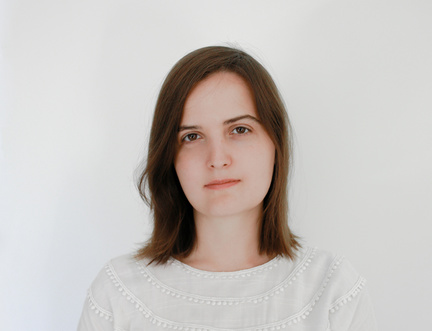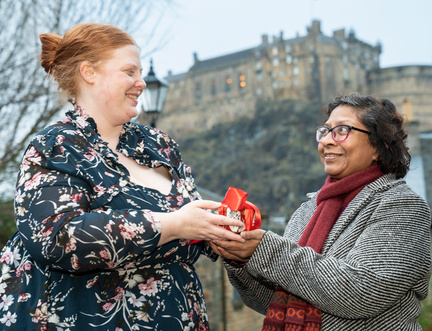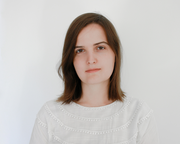El Toldo / The Awning
By Gabriela Ybarra

In 2018, we commissioned 51 authors from 25 countries to write essays exploring ideas about freedom for The Freedom Papers, a publication produced in partnership with Gutter Magazine. Read on for Gabriela Ybarra's essay (in both Spanish and English), and visit guttermag.co.uk to purchase a copy of The Freedom Papers.
Durante muchos años hubo una librería en la calle Bailén de Madrid, justo enfrente de la catedral de la Almudena, que tenía un toldo que decía: ‘Ser cultos para ser libres’. Nunca entré. Tampoco visité el negocio que abrió después de su cierre, La Ecotedral, una cafetería y heladería ecológica dirigida a turistas. Los nuevos inquilinos mantuvieron el toldo con algunos cambios: encima de la palabra cultos pegaron un trozo de tela negra con la palabra ‘eco’y sobre la palabra ‘libres’ colocaron otro retal de tela oscura. La nueva frase decía: ‘Ser eco para ser’. La Ecotedral tampoco prosperó, pero durante el año que estuvo abierta, cada vez que pasaba por delante de su cristalera me sentía fatal. ¿Ser eco para ser?, ¿por qué me molestaba tanto este eslogan? El toldo parcheado despertó en mí más preguntas que el anterior. La frase de la librería me parecía rotunda e incontestable. Cuando paraba con el coche delante del semáforo que hay en el cruce de la calle Bailén con la calle Mayor y leía: ‘Ser cultos para ser libres’, recordaba las paredes repletas de libros de mi casa y me sentía inteligente y leída. Sin embargo, la frase del toldo de la cafetería me incomodaba. Llevaba ya tres años viviendo en el centro de Madrid y siempre había convivido con los turistas, pero hasta que no abrió la Ecotedral y sus dueños taparon la palabra libertad con un parche, no fui consciente de en qué medida nuestro distrito había sido conquistado por esta comunidad flotante de extranjeros.
Cada vez que cierra una tienda de barrio y en su lugar abre un comercio que ofrece servicios a los turistas, me acuerdo del toldo tapado y me siento un poco menos libre. Con cada cambio de negocio los vecinos perdemos otro espacio en donde encontrarnos. En los últimos meses, en la calle Mayor, ha abierto una tienda de bolsos chinos en el local que antes ocupaba la carnicería Hermanos Lechuga, un negocio de suvenires en donde estaba la floristería Elisabeth Blumen y un establecimiento de cambio de moneda en un espacio que llevaba un lustro vacío. La vía se ha ido turistificando hasta convertirse en un sucedáneo de sí misma; en un camino más fácil de transitar para los turistas, pero con negocios inservibles para los vecinos. Esta calle emblemática de Madrid ha dejado de ser Madrid para convertirse en lo que los visitantes esperan de la ciudad. Algunos ejemplos de esta tendencia son el número de tiendas de embutidos que han abierto en los últimos dos años y la cantidad de fotos de paellas que cuelgan de las fachadas de las cafeterías. Aunque en Madrid siempre ha habido algún que otro restaurante de arroces y no es difícil encontrar buen jamón, ninguna de las dos comidas son típicas de la capital. Sin embargo, la mayoría de los extranjeros que visitan la ciudad no son expertos en gastronomía castiza y lo que esperan encontrar en los menús de los bares de tapas no son ni los callos ni el cocido típicos de la cocina local, sino los embutidos y las paellas que aparecen en los folletos de los turoperadores que venden nuestro país como destino. A veces, cuando paseo por las calles y por las plazas de mi barrio y veo los grupos de turistas, me siento como una figurante dentro de un decorado. La semana pasada me crucé con una pareja de ancianos del norte de Europa que ojeaba una guía de viaje y me acordé de las descripciones de restaurantes que a veces aparecen en estas publicaciones: ‘Establecimiento con encanto en donde los extranjeros se mezclan con los locales’ y me imaginé a mi marido y a mí, como figuras de atrezo, compartiendo una ración de calamares en una mesa junto a la ventana.
Hoy me pregunto qué puedo hacer para no sentirme arrinconada en mi barrio. Podría seguir analizando la turistificación, listar las tiendas tradicionales que han cerrado y contar el número de vecinos que han tenido que mudarse a la periferia por culpa del auge de Airbnb, pero no creo que este conocimiento pueda ayudarme a reconquistar mi ciudad. La mejor acción de protesta que se me ocurre para reivindicar mi espacio es mantener mi ritmo de vecina al caminar, que unas veces es más rápido y otras es más lento que el de los extranjeros que visitan el centro histórico de Madrid. Desde que tomé la decisión de moverme a paso de vecina, ya no me da apuro cruzarme delante de los turistas que sacan fotografías, ni tengo reparo en apartar a los transeúntes que avanzan lentos, como en un domingo perpetuo, taponando las aceras. El otro día, mientras cruzaba el viaducto de Segovia, no dejé que me adelantara una hilera larguísima de italianos en segway. El grupo motorizado tuvo que recorrer el trayecto detrás de mí, a mi velocidad de paseo. Ni siquiera tuve remordimientos al pararme a mitad del puente para contemplar el paisaje.
Mientras la ciudad se transforma, yo sigo caminando a ritmo de protesta y busco dentro de mi barrio las islas en las que sobrevive Madrid. Isla, así es como se llamaba la librería del toldo que me hizo caer en la autocomplacencia. El local en donde antes estaba este negocio y en donde después abrió La Ecotedral sigue vacío. Cuando cerró la cafetería heladería ecológica, sus dueños se llevaron los parches que cubrían la cita del poeta cubano José Martí. Ahora, si uno se fija, porque la tela del toldo está muy gastada por el sol y por el pegamento, se puede volver a leer la frase ‘Ser cultos para ser libres’. Quizás esta no sea una gran victoria sobre la invasión turística, pero a mí me reconforta haber recuperado el toldo.
***
Translated by Natasha Wimmer
For years there was a bookstore on Calle Bailén in Madrid, across from the Catedral de la Almudena, with an awning that read: ‘Ser cultos para ser libres’ (Be educated to be free). I never went in. Nor did I visit the place that opened there after it closed: La Ecotedral, an eco-café and ice cream shop catering to tourists. The new tenants kept the awning, with some changes: over the word ‘cultos’ they stuck a piece of black fabric printed with the word ‘eco’, and over ‘libres’ they pasted another strip of dark fabric. The new line read: ‘Ser eco para ser’ (Be eco to be). The Ecotedral didn’t thrive either, but for the year that it was open, every time I passed its window I felt awful. Be eco to be? Why did that line bother me so much? The patched awning raised questions for me that its predecessor had not. The bookstore slogan struck me as solid and indisputable. When I stopped in my car at the light at the intersection of Calle Bailén and Calle Mayor and read: ‘Ser cultos para ser libres,’ I remembered the book-filled walls at home and I felt intelligent and well-read. Meanwhile, the words on the café’s awning made me uncomfortable. I had been living in the centre of Madrid for three years and I had always coexisted with tourists, but it wasn’t until the Ecotedral opened and its owners covered up the word ‘freedom’ with a patch that I was conscious of the extent to which our neighbourhood had been conquered by this floating community of foreigners.
Every time a neighbourhood shop closes and is replaced by a business geared for tourists, I remember the blacked-out awning and I feel a little bit less free. With each turnover the locals lose another place to meet up. On Calle Mayor, in just the last few months, a Chinese handbag shop has opened in the spot once occupied by Hermanos Lechuga, the butcher; a souvenir shop has replaced Elisabeth Blumen, the florist; and a currency exchange bureau has taken over a vacant storefront. The street has become touristified to the point of turning into a simulacrum of itself; it has become an easier route for tourists to travel, but with businesses that are of no use to locals. This archetypal Madrid street is no longer Madrid, having become instead what visitors to the city expect it to be. Some examples of this shift are the number of charcuterie shops that have opened in the last two years, and the quantity of photographs of paellas hanging in café windows. Though there has always been the occasional rice restaurant in Madrid and it isn’t hard to find good serrano ham, neither of the two foods are typical of the capital. But most of the foreigners who visit the city aren’t experts in Castillian gastronomy and what they expect to find on the menus at tapas bars aren’t local specialties like tripe or the chickpea stew called cocido but the sausages and paellas seen in the tourist brochures that sell our country as a destination. Sometimes, when I walk down the streets and through the plazas of my neighbourhood and I see groups of tourists, I feel like part of the scenery. Last week I crossed paths with an older couple from the north of Europe who were consulting a guide book and I was reminded of the kind of restaurant write-ups that appear in such books: ‘Charming spot where foreigners mingle with locals’ and I imagined my husband and myself, like figures in a stage set, sharing a plate of calamares at a window table.
Today I ask myself what I can do not to feel crowded out in my own neighbourhood. I could continue to document the touristification, listing the traditional shops that have closed and counting the number of neighbours who’ve had to move to the suburbs because of the rise of Airbnb, but I don’t believe that this knowledge will help me take back my city. The best protest action I can think of to reclaim my space is to walk at the pace of a local, sometimes faster and sometimes slower than the foreigners visiting the historic centre of Madrid. Ever since I made the decision to walk like a local, I no longer hurry to get out of the way of photo-snapping tourists, nor do I have qualms about pushing past pedestrians moving at a leisurely pace, as if on a perpetual Sunday, blocking the sidewalks. The other day, as I crossed the Segovia Viaduct, I purposely didn’t make way for a long line of Italians on Segways. The motorized group had to cross the bridge behind me, at walking speed. I didn’t even feel bad about stopping halfway across to gaze at the view.
As the city is transformed, I keep walking at protest pace and I seek out the islands in my neighbourhood where Madrid still survives. Island, or Isla, was the name of the bookstore with the awning that made me lapse into complacency. The storefront where it used to be, and where La Ecotedral opened after that, is still empty. When the eco café closed, its owners removed the patches that covered up the quote from the Cuban poet José Martí. Now, if you look closely – the letters are faded and worn away by glue and the sun – you can once again read the phrase ‘To be educated is to be free.’ This may not be a great victory over the tourist invasion, but it comforts me to have the awning back.
Copyright © 2018, Gabriela Ybarra. All rights reserved.
Supported by the Scottish Government’s Edinburgh Festivals Expo Fund through Creative Scotland.
Look, Listen & Read
- 2025 Festival:
- 9-24 August
Latest News
 Communities Programme participants celebrate success of 2024
Communities Programme participants celebrate success of 2024




